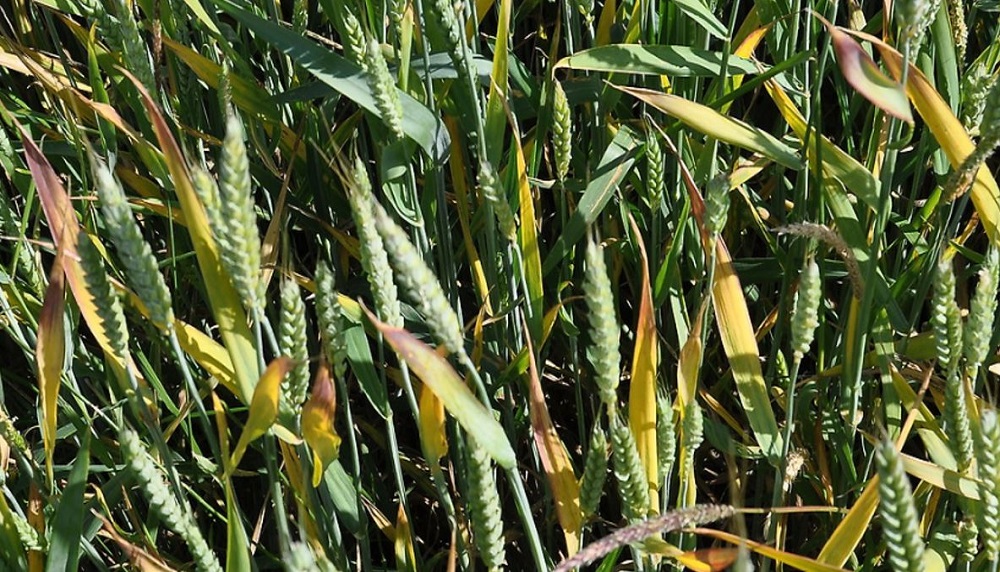Barley yellow dwarf virus (BYDV) in autumn 2024 aphids
Tuesday, 10 September 2024
This autumn, we are monitoring BYDV in cereal aphids and have reset our BYDV management tool to guide spray decisions. Jason Pole explains.
Mainly spread by bird cherry-oat aphids and grain aphids, Barley yellow dwarf virus (BYDV) can cause significant yield losses in UK cereals.
BYDV is unusual because it is a complex of viruses made up of variants/isolates, with some transmitted by more than one aphid species. For example:
- BYDV-PAV is spread by several aphids, including bird cherry-oat aphids and grain aphids
- BYDV-MAV is mainly spread by grain aphids
The BYDV complex also features the closely related Cereal yellow dwarf virus (CYDV).
- CYDV-RPV (BYDV-RPV) is spread by bird cherry-oat aphids
In 2018, Rothamsted Research successfully tested a molecular method (PCR-based assay) that detects BYDV and CYDV in single aphids (even at very low levels). In terms of understanding BYDV specifics, it was a game changer.
Not only does it provide a robust way to assess the proportion of aphids that carry the virus, it also delivers better data on the variants.
Aphid monitoring
Since 2018, we have funded PCR screens of aphid catches from the suction trap network.
The network, which is funded by the Biotechnology and Biological Sciences Research Council (BBSRC), uses giant (12.2 m tall) suction traps to continuously hoover flying insects out of the air.
Trap contents are identified and counted by the Rothamsted Insect Survey (RIS).
Catches from the 16-strong network are published in regular bulletins at insectsurvey.com/aphid-bulletin
The AHDB virus screens are based on up to 96 aphid samples (bird cherry-oat and grain aphids) caught each week during the autumn from four suction traps across England.
Virus results
Results from previous autumns show that most aphids do not carry BYDV/CYDV. For example, data from the last three autumns (2021–23) showed that the mean proportion of viruliferous aphids never exceeded 30% (note: some weekly results exceeded this figure).
The data also helps us to spot over-season trends. For example, virus levels tend to be highest at sites in regions with more permanent grassland (which acts as a reservoir for aphids and BYDV).
In terms of variants, BYDV-PAV is considered the most prevalent species globally.
Although CYDV-RPV is generally less prevalent in our data, it is not clear-cut. In some seasons at some sites, it has nearly matched, and occasionally surpassed, BYDV-PAV/MAV. This matters. For example, we know that the variant has implications for selecting plant lines with varietal tolerance or resistance.
This autumn, we will publish data on virus levels once more. Keep an eye on the aphid monitoring pages for the latest data.
BYDV tool
The current AHDB BYDV management tool for cereals is a relatively simple (and effective) decision support system. It estimates when the second aphid generation (most associated with BYDV spread) is likely to be present, based on accumulated daily air temperatures. The temperature sum starts at crop emergence or after a spray.
We have refreshed the tool to guide spray decisions this autumn.
Ongoing AHDB research, led by Sacha White (who recently joined the AHDB IPM team from ADAS), has investigated a tool with the potential to better predict aphid population dynamics. It considers aphid-pressure data, the amount that carry the virus and the economics of applying an insecticide.
The research also examined how representative suction trap samples are in relation to the wider population.
In terms of virus, it found that data on the percentage of viruliferous aphids was reliable over a greater area than previously thought, with accuracy good up to 40 km away.
The tool, called Acrobat, also considers enhanced temperature data (such as minimum, maximum and mean temperatures) and additional crop data (such as cereal crop type, BYDV tolerance status, sowing date, plant populations, treatment costs, predicted yield, estimated grain price and local risk factors).
In surveys of untreated crops, Acrobat accurately predicted BYDV risk (based on symptom development).
In tramline and plot trials, Acrobat-guided sprays provided consistent BYDV control, as good as or better than the current BYDV management tool.
The better news is that it did this with fewer insecticide applications and provided yield benefits (where BYDV was present).
As the Acrobat tool can indicate potential risk, it can also inform pre-sowing decisions (such as crop choice and drilling date).
 AHDB
AHDB
Next steps
With proof of concept established, Acrobat requires development work to produce a version for industry.
Regulation (neonicotinoids withdrawal) and resistance (to pyrethroids) mean that the power to tackle aphids with chemistry has waned.
Investing in approaches that reduce the industry’s reliance on plant protection projects continues to be a priority for AHDB investment.
We are actively discussing ways to bring the Acrobat tool to farmers – watch this space.
The tool is also being tested at Strategic Cereal Farm East (watch the video for details).
In this video, Amy Catling, AHDB Senior Knowledge Exchange Manager, discusses the BYDV trials (harvest 2024) at Strategic Cereal Farm East, with host David Jones.
Variety data
In the Recommended Lists (RL) for cereals and oilseeds, we use specialist categories and described types to provide specific recommendations for varieties that have novel traits. BYDV resistance/tolerance in cereals is a specialist trait we added to the RL in the last few years.
While RL trial operators do record BYDV symptoms in trials, it is difficult to set up a fair test of resistance/tolerance due to the sporadic nature of the disease – across trials, plots and even within plots. This is why we ask breeders to provide evidence to support their claims.
Although we do not verify their claims in RL trials, sometimes trials deliver their own unplanned verdict on crop genetics. This was illustrated perfectly by RL barley trials in Dorset, grown for harvest 2021.
This showed that, where BYDV infection is a serious threat, BYDV tolerance is a useful trait, with measurable yield benefits.
Read an article about the harvest 2021 RL barley trials
See the RL for the latest information on varieties with tolerance or resistance to BYDV: ahdb.org.uk/rl


